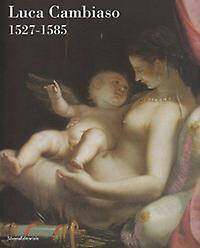
- Retrait gratuit dans votre magasin Club
- 7.000.000 titres dans notre catalogue
- Payer en toute sécurité
- Toujours un magasin près de chez vous
- Retrait gratuit dans votre magasin Club
- 7.000.000 titres dans notre catalogue
- Payer en toute sécurité
- Toujours un magasin près de chez vous
Description
Luca Cambiaso (Moneglia, Italy 1527 – El Escorial, Spain 1585) was one of the major figures in the artistic panorama of the mid 16th century, when Genoa, in a period of great vitality and flourishing economy, confirmed its leading role and the prestige of its aristocracy both in Italy and in Europe.
Forty years after the last exhibition on the painter, an important new exhibition is organized to pay homage to him, proposing to the public what emerged during the recent studies of the last years. What emerges and stands as assumption of the exhibition is the unique character of the Ligurian artist in his connection with the great masters of the 16th century – Michelangelo, Correggio, Titian – and his European dimension widely recognized by critics. The exhibition will have two venues: the Blanton Museum of Art at The University of Texas at Austin and afterwards Palazzo Ducale in Genoa. Approximately one hundred works will be displayed, including paintings, drawings, sculptures, tapestries, miniatures and silvers: high-level works that allow the viewer to follow the artistic path of Cambiaso, from his experience in youth to his activity for the Spanish court.
The richness of the awesomeness caught by this artist’s sensitiveness will emerge also in relation to the comparative masterpieces by great artists of the same century: Michelangelo, Giulio Romano, Perin del Vaga, Beccafumi, Correggio, Titian, Veronese and artists of international Mannerism.
The volume includes critical essays by Arturo Pacini,Lauro Magnani, Jonathan Bober, Piero Boccardo and Clario di Fabio, Franco Boggero and Massimo Bartoletti, Giulio Bora, and Ezia Gavazza. Gianni Carlo Sciolla analyses how the critics perceived the artist during the centuries, whereas Carmen Garcia-Frias focuses on the artist’s fortune in Spain. The volume is completed by a documentary appendix curated by Alfonso Assini and Roberto Santamaria.
Forty years after the last exhibition on the painter, an important new exhibition is organized to pay homage to him, proposing to the public what emerged during the recent studies of the last years. What emerges and stands as assumption of the exhibition is the unique character of the Ligurian artist in his connection with the great masters of the 16th century – Michelangelo, Correggio, Titian – and his European dimension widely recognized by critics. The exhibition will have two venues: the Blanton Museum of Art at The University of Texas at Austin and afterwards Palazzo Ducale in Genoa. Approximately one hundred works will be displayed, including paintings, drawings, sculptures, tapestries, miniatures and silvers: high-level works that allow the viewer to follow the artistic path of Cambiaso, from his experience in youth to his activity for the Spanish court.
The richness of the awesomeness caught by this artist’s sensitiveness will emerge also in relation to the comparative masterpieces by great artists of the same century: Michelangelo, Giulio Romano, Perin del Vaga, Beccafumi, Correggio, Titian, Veronese and artists of international Mannerism.
The volume includes critical essays by Arturo Pacini,Lauro Magnani, Jonathan Bober, Piero Boccardo and Clario di Fabio, Franco Boggero and Massimo Bartoletti, Giulio Bora, and Ezia Gavazza. Gianni Carlo Sciolla analyses how the critics perceived the artist during the centuries, whereas Carmen Garcia-Frias focuses on the artist’s fortune in Spain. The volume is completed by a documentary appendix curated by Alfonso Assini and Roberto Santamaria.
Spécifications
Parties prenantes
- Auteur(s) :
- Editeur:
Contenu
- Nombre de pages :
- 480
- Langue:
- Anglais
Caractéristiques
- EAN:
- 9788836607341
- Date de parution :
- 20-10-06
- Format:
- Livre broché
- Dimensions :
- 230 mm x 280 mm
- Poids :
- 2400 g







